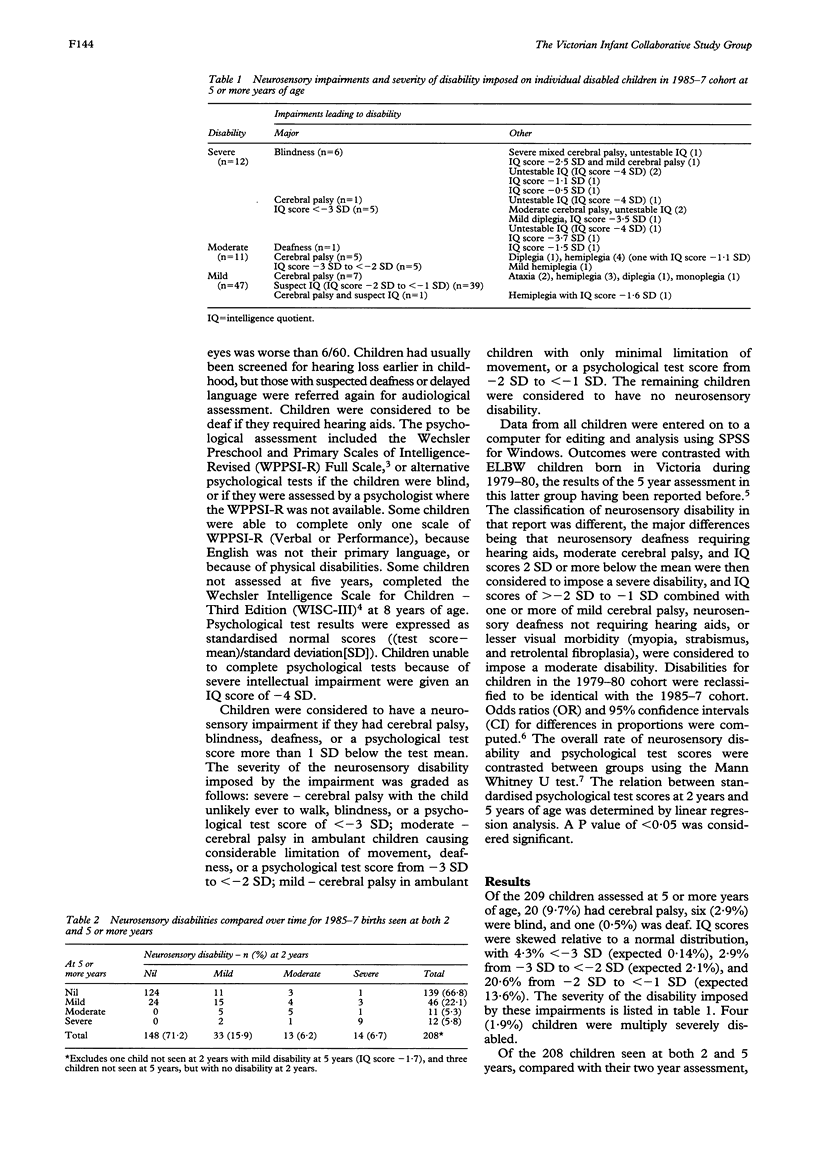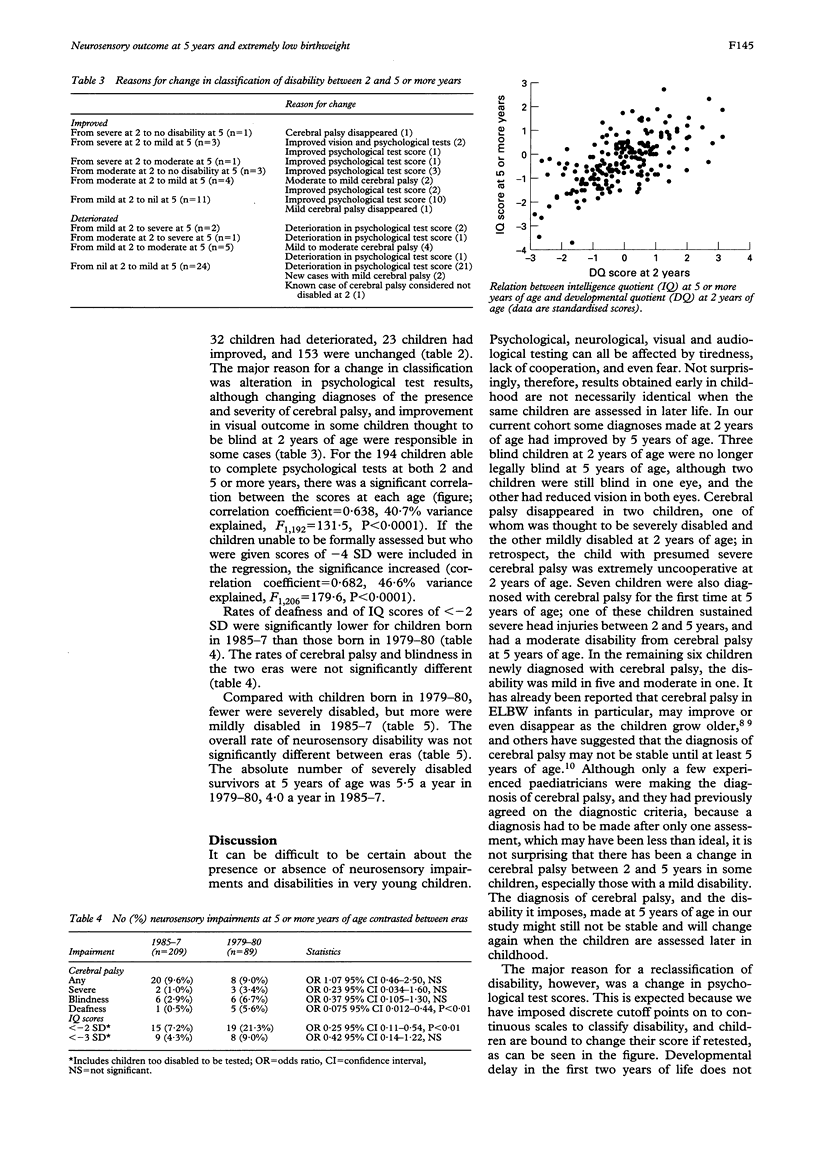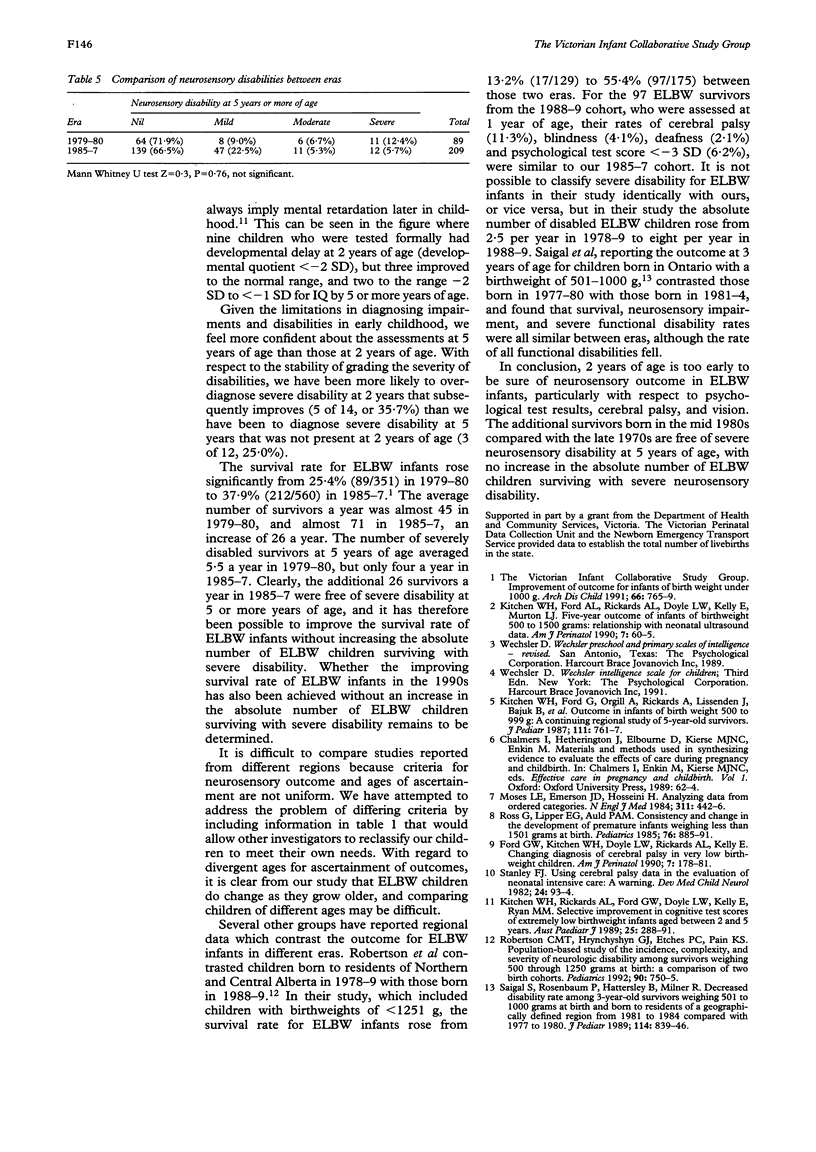Abstract
OBJECTIVE--To establish the stability of neurosensory outcome at 5 years of age compared with 2 years of age, and to determine whether the improving survival rate of extremely low birthweight (ELBW) (500-999 g) children has been accompanied by an increase in the number of severely impaired and disabled children in the community. METHODS--A geographically determined cohort study was made of consecutive ELBW survivors born in the state of Victoria during 1985-7, and during 1979-80, inclusive. Rates of neurosensory impairments and disabilities at 2 and 5 or more years of age were measured. RESULTS--Of 212 children surviving to 5 years of age born during 1985-7, 211 (99.5%) had been assessed at 2 years of age, and 209 (98.6%) were assessed at 5 or more years of age. Of the 208 children seen at both 2 and 5 years, 32 children had deteriorated, 23 children had improved, and 153 were unchanged, compared with their 2 year assessment. The major reason for a change in classification was an alteration in psychological test results. Compared with ELBW children born in 1979-80, those born in 1985-7 had significant reductions in hearing and intellectual impairment. The rate of severe neurosensory disability in the 1985-7 cohort was 5.7% compared with 12.4% in children born in 1979-80. CONCLUSIONS--The age of 2 is too early to be sure of neurosensory outcome in ELBW infants. The additional survivors born in the mid 1980s, compared with the late 1970s, are free of severe neurosensory disability at 5 years of age, with no increase in the absolute number of ELBW children surviving with severe neurosensory disability.
Full text
PDF



Selected References
These references are in PubMed. This may not be the complete list of references from this article.
- Ford G. W., Kitchen W. H., Doyle L. W., Rickards A. L., Kelly E. Changing diagnosis of cerebral palsy in very low birthweight children. Am J Perinatol. 1990 Apr;7(2):178–181. doi: 10.1055/s-2007-999475. [DOI] [PubMed] [Google Scholar]
- Kitchen W. H., Rickards A. L., Ford G. W., Doyle L. W., Kelly E., Ryan M. M. Selective improvement in cognitive test scores of extremely low birthweight infants aged between 2 and 5 years. Aust Paediatr J. 1989 Oct;25(5):288–291. doi: 10.1111/j.1440-1754.1989.tb01479.x. [DOI] [PubMed] [Google Scholar]
- Kitchen W., Ford G., Orgill A., Rickards A., Astbury J., Lissenden J., Bajuk B., Yu V., Drew J., Campbell N. Outcome in infants of birth weight 500 to 999 g: a continuing regional study of 5-year-old survivors. J Pediatr. 1987 Nov;111(5):761–766. doi: 10.1016/s0022-3476(87)80264-0. [DOI] [PubMed] [Google Scholar]
- Moses L. E., Emerson J. D., Hosseini H. Analyzing data from ordered categories. N Engl J Med. 1984 Aug 16;311(7):442–448. doi: 10.1056/NEJM198408163110705. [DOI] [PubMed] [Google Scholar]
- Robertson C. M., Hrynchyshyn G. J., Etches P. C., Pain K. S. Population-based study of the incidence, complexity, and severity of neurologic disability among survivors weighing 500 through 1250 grams at birth: a comparison of two birth cohorts. Pediatrics. 1992 Nov;90(5):750–755. [PubMed] [Google Scholar]
- Ross G., Lipper E. G., Auld P. A. Consistency and change in the development of premature infants weighing less than 1,501 grams at birth. Pediatrics. 1985 Dec;76(6):885–891. [PubMed] [Google Scholar]
- Saigal S., Rosenbaum P., Hattersley B., Milner R. Decreased disability rate among 3-year-old survivors weighing 501 to 1000 grams at birth and born to residents of a geographically defined region from 1981 to 1984 compared with 1977 to 1980. J Pediatr. 1989 May;114(5):839–846. doi: 10.1016/s0022-3476(89)80150-7. [DOI] [PubMed] [Google Scholar]
- Stanley F. J. Using cerebral palsy data in the evaluation of neonatal intensive care: a warning. Dev Med Child Neurol. 1982 Feb;24(1):93–94. doi: 10.1111/j.1469-8749.1982.tb13594.x. [DOI] [PubMed] [Google Scholar]


